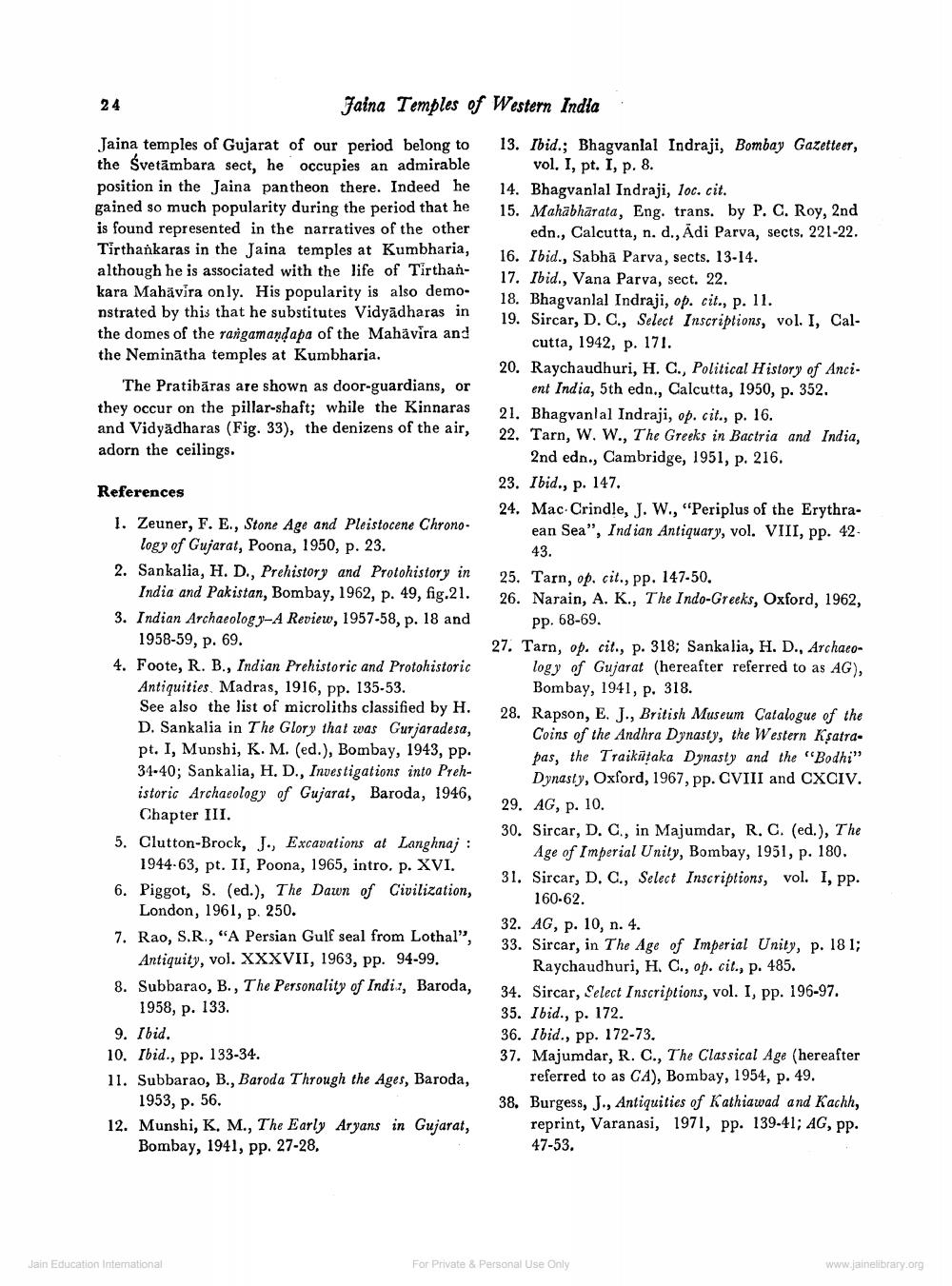________________
24
Faina Temples of Western India
Jaina temples of Gujarat of our period belong to the Svetämbara sect, he occupies an admirable position in the Jaina pantheon there. Indeed he gained so much popularity during the period that he is found represented in the narratives of the other Tirthankaras in the Jaina temples at Kumbharia, although he is associated with the life of Tirthankara Mahävira on ly. His popularity is also demonstrated by this that he substitutes Vidyādharas in the domes of the rangamand apa of the Mahävira and the Neminātha temples at Kumbharia.
The Pratibāras are shown as door-guardians, or they occur on the pillar-shaft; while the Kinnaras and Vidyadharas (Fig. 33), the denizens of the air, adorn the ceilings.
References 1. Zeuner, F. E., Stone Age and Pleistocene Chrono
logy of Gujarat, Poona, 1950, p. 23. 2. Sankalia, H. D., Prehistory and Protohistory in
India and Pakistan, Bombay, 1962, p. 49, fig.21. 3. Indian Archaeology-A Review, 1957-58, p. 18 and
1958-59, p. 69. 4. Foote, R. B., Indian Prehistoric and Protohistoric
Antiquities. Madras, 1916, pp. 135-53. See also the list of microliths classified by H. D. Sankalia in The Glory that was Gurjaradesa, pt. I, Munshi, K. M. (ed.), Bombay, 1943, pp. 34-40; Sankalia, H, D., Investigations into Prehistoric Archaeology of Gujarat, Baroda, 1946,
Chapter III. 5. Clutton-Brock, J., Excavations at Langhnaj :
1944-63, pt. II, Poona, 1965, intro. p. XVI. 6. Piggot, S. (ed.), The Dawn of Civilization,
London, 1961, p. 250. 7. Rao, S.R., "A Persian Gulf seal from Lothal”,
; Antiquity, vol. XXXVII, 1963, pp. 94-99. 8. Subbarao, B., The Personality of India, Baroda,
1958, p. 133. 9. Ibid. 10. Ibid., pp. 133-34. 11. Subbarao, B., Baroda Through the Ages, Baroda,
1953, p. 56. 12. Munshi, K, M., The Early Aryans in Gujarat,
Bombay, 1941, pp. 27-28.
13. Ibid.; Bhagvanlal Indraji, Bombay Gazetteet,
vol. I, pt. I, p. 8. 14. Bhagvanlal Indraji, loc. cit. 15. Mahabharata, Eng. trans. by P. C. Roy, 2nd
edn., Calcutta, n. d., Adi Parva, sects, 221-22. 16. Ibid., Sabha Parva, sects. 13-14. 17. Ibid., Vana Parva, sect. 22. 18. Bhagvanlal Indraji, op. cit., p. 11. 19. Sircar, D. C., Select Inscriptions, vol. I, Cal
cutta, 1942, p. 171. 20. Raychaudhuri, H. C., Political History of Anci.
ent India, 5th edn., Calcutta, 1950, p. 352. 21. Bhagvanlal Indraji, op. cit., p. 16. 22. Tarn, W. W., The Greeks in Bactria and India,
2nd edn., Cambridge, 1951, p. 216. 23. Ibid., p. 147. 24. Mac Crindle, J. W., "Periplus of the Erythra
ean Sea", Indian Antiquary, vol. VIII, pp. 42
43. 25. Tarn, op. cit., pp. 147-50. 26. Narain, A. K., The Indo-Greeks, Oxford, 1962,
Pp. 68-69. 27. Tarn, op. cit., p. 318; Sankalia, H. D., Archaeo
logy of Gujarat (hereafter referred to as AG),
Bombay, 1941, p. 318. 28. Rapson, E. J., British Museum Catalogue of the
Coins of the Andhra Dynasty, the Western Ksatrapas, the Traikātaka Dynasty and the "Bodhi"
Dynasty, Oxford, 1967, pp. CVIII and CXCIV. 29. AG, p. 10. 30. Sircar, D. C., in Majumdar, R. C. (ed.), The
Age of Imperial Unity, Bombay, 1951, p. 180. 31. Sircar, D. C., Select Inscriptions, vol. I, pp.
160-62. 32. AG, p. 10, n. 4. 33. Sircar, in The Age of Imperial Unity, p. 181;
Raychaudhuri, H. C., op. cit., p. 485. 34. Sircar, Select Inscriptions, vol. I, pp. 196-97. 35. Ibid., p. 172. 36. Ibid., pp. 172-73. 37. Majumdar, R. C., The Classical Age (hereafter
referred to as CA), Bombay, 1954, p. 49. 38. Burgess, J., Antiquities of Kathiawad and Kachh,
reprint, Varanasi, 1971, pp. 139-41; AG, pp. 47-53.
Jain Education International
For Private & Personal Use Only
www.jainelibrary.org




